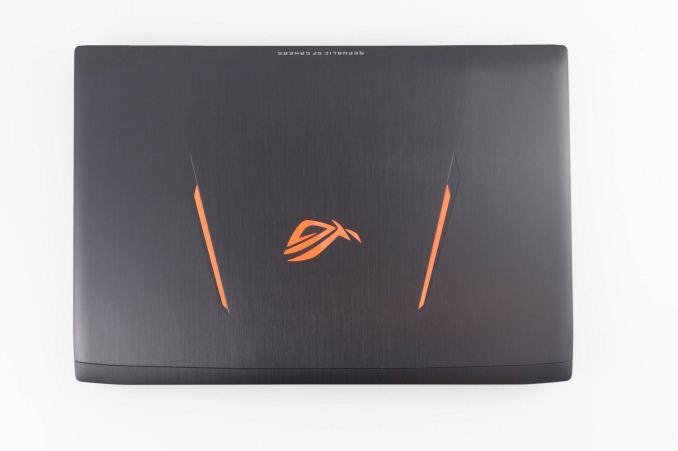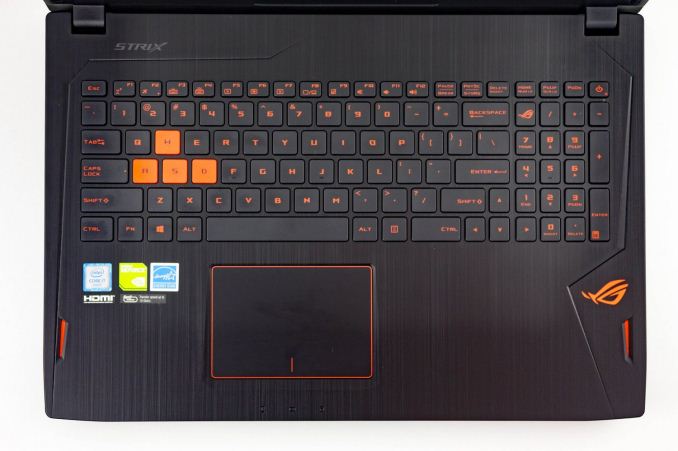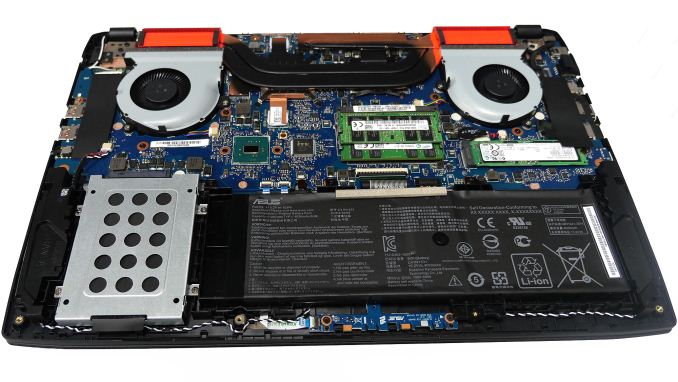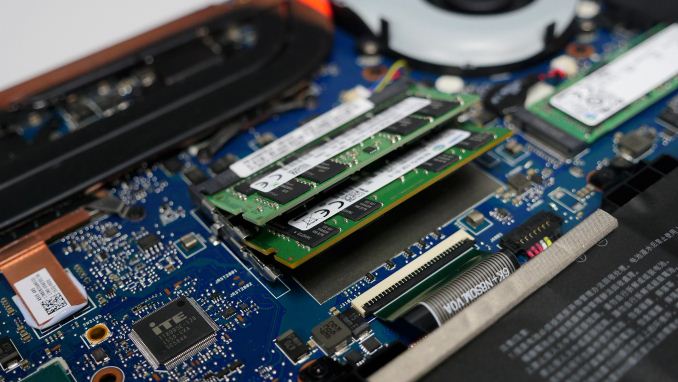The ASUS ROG Strix GL502VS Review: Mainstream GTX 1070 with G-SYNC
by Brett Howse on December 9, 2016 8:00 AM ESTDesign
Without putting too fine a point on it, ASUS can design some stunning notebooks, but this is not one of them. Stepping down to their value line keeps the same powerful internals, but to hit this price point ASUS has taken some liberties with the chassis design. The entire notebook is built from a fairly low quality plastic, with the exception of the lid which has a metal top. The top has a brushed finish with lines running parallel down the entire device, which looks nice, but that’s where the premium materials end.
Opening the notebook, the same brushed finish is replicated on the plastic keyboard deck, but this time on the plastic finish. The keyboard itself features 1.6 mm of travel with red backlighting, but the keyboard feel lacks the nice feel of some of the other ASUS notebooks. The WASD keys are red with black fonts, compared to the rest of the keys which are black with red fonts, and although the look won’t appeal to everyone, it does help quickly identify the most needed keys for gaming. ASUS continues its silly tradition of having the power key right in the keyboard, with it at the top right. If you accidently go to press the minus key, you may end up shutting off the laptop. There’s no good reason for them to put it there, although at least on this notebook, with its extra number pad, it is less likely to get hit than on one of their smaller notebooks where it is right beside the delete key. This seems like a small gripe, but shutting off your computer when going to hit a key is not a great experience.
The trackpad on this notebook does feature the Microsoft Precision Touchpad drivers, for better or for worse, and it’s nice to see Microsoft reigning this in. They still have some work to do with the drivers, but at least it is a consistent experience across devices now. That being said, the trackpad on this notebook is not quite as smooth as some other notebooks, and picks up fingerprints quite readily. It would be nice to see a glass trackpad, although once again the budget comes into play. Luckily a good mouse is going to be required for gaming regardless, so this isn’t as big of an issue as it is on a more portable device.
Being a large gaming laptop, there is expandability with the GL502VS, and just a couple of screws will let you pop off the bottom and access the memory, which has two SODIMM slots, the M.2 SSD, and the SATA drive. Maximum memory is 32 GB through two 16 GB DDR4 modules. On our 16GB sample, only one memory slot was occupied for single channel memory performance.
Interior photos courtesy of rog.asus.com
Overall the design of the ASUS GL502VS is kind of disappointing. The top of the notebook is a very nice looking metal, but the remainder of the notebook is a fairly low grade plastic. ASUS does build some nice notebooks, but to hit their budget on this one with the components on the inside, clearly some cost cutting was necessary. They have also gone a bit overboard with the red accents on this notebook, and especially with the bright shade of red chosen, although the almost orange WASD keys do look nice and red with the keyboard backlighting on.

















54 Comments
View All Comments
nathanddrews - Friday, December 9, 2016 - link
Is $1600 mainstream?Hopefully we see FreeSync (or G-Sync) laptops on the "low end" $800 laptops. Seems like a ripe market for Adaptive Sync technologies, given the lesser performance of GTX 960m and similar parts.
close - Friday, December 9, 2016 - link
Given the prices I saw recently on deeply flawed (unbalanced) gaming machines, ~$1600 for something that comes with more than decent CPU, GPU and SSD might as well be called mainstream. The rest is still compromised as opposed to a proper gaming machine (small screen, integrated keyboard and touchpad) but at least you get a reasonable package for a relatively reasonable price.Do not compare it to a desktop. The desktop will still be twice as cheap and a lot more powerful for a long time.
xenol - Friday, December 9, 2016 - link
Find me a complete desktop system (that includes all of I/O) that performs about the same for half the cost.sorten - Friday, December 9, 2016 - link
It would be difficult to find a comparable desktop for the comparison. You could probably go with an i5 65W CPU and it would significantly outperform the laptop's 45W i7. The 1070 is the same for desktop and mobile, but much more thermal headroom on the desktop. Memory and SSDs are cheap. I also wouldn't count the cost of the monitor in the comparison, because the only time I wouldn't dock the laptop so I could use my 27" monitor would be in the rare trip to a hotel or similar place.The other thing is that anyone who is building a desktop for gaming is only replacing one or two components. For example, I could build a faster desktop gaming system than this laptop by just spending the $400 on the GPU. I've had the same case, PSU, optical drive, etc. for probably 7 or 8 years.
Samus - Sunday, December 11, 2016 - link
The other thing to keep in mind is you can build a mini ITX system with an i7 and GTX1070 while still being incredibly tiny, less expensive and more capable (aside from being slightly more bulky and lacking battery power.)But that's the real killer with gaming laptops. Unless they are DTR's, they are too weak in graphics performance, and when they are DTR's, battery life is a joke anyway.
close - Tuesday, December 13, 2016 - link
@xenol, if it's any easier for you to understand read it as "performance/$". Or do you specifically want me to lookup some desktop CPUs/GPUs that are gimped by thermal headroom to match the equivalent laptop ones, a case that allows for close to 0 upgradeability, a 15" mediocre screen, crappy keyboard, integrated buzzers... erm, speakers, and a touchpad instead of a mouse?I was talking more of a hypothetical equivalent since it's hard to build a desktop that matches *any* gaming laptop in compromises. Yeah, I get that if you want portability a laptop is the way to go. It's still a severely compromised machine, it's still extremely expensive for the hardware but maybe the difference is how much "portability" costs.
Donny2005UK - Wednesday, January 11, 2017 - link
https://www.amazon.com/Lenovo-Ideacentre-Y700-Desk... Sorry cheapest I could find with a decent cpumrmcmurren - Wednesday, February 1, 2017 - link
hey if you are intested i am selling my desktop with better specs for a great price 1200email me at mrmcmurren@gmail.com
specs as follows
BLUETOOTH: None
CASUPGRADE: None
CD: 24X Double Layer Dual Format DVD+-R/+-RW + CD-R/RW Drive (BLACK COLOR)
CD2: None
COOLANT: Standard Coolant
CPU: Intel(R) Core� i7-3820 Quad-Core 3.60 GHz 10MB Intel Smart Cache LGA2011 (All Venom OC Certified)
CS_FAN: Maximum 120MM Color Case Cooling Fans for your selected case
FA_HDD: None
FAN: Asetek 510LC Liquid Cooling System 120MM Radiator & Fan (Enhanced Cooling Performance + Extreme Silent at 20dBA) (Single Standard 120MM Fan)
FLASHMEDIA: None
GLASSES: None
HDD: 2TB (2TBx1) SATA-III 6.0Gb/s 64MB Cache 7200RPM HDD (Single Drive)
HDD2: None
IEEE_CARD: None
MEMORY: 16GB (4GBx4) DDR3/1866MHz Quad Channel Memory (Corsair Vengeance [Free upgrade from 1600MHz Major Brand])
MONITOR: None
MONITOR2: None
MONITOR3: None
MOTHERBOARD: (3-Way SLI/CrossFireX Support) ASUS P9X79 LE Intel X79 Chipset Quad Channel DDR3 ATX w/ Remote GO!, 7.1 HD Audio, GbLAN, 3 Gen3 PCIe X16, 2 PCIe X1 & 1 PCI
NETWORK: Onboard Gigabit LAN Network
OS: Microsoft(R) Windows 8 Pro (64-bit Edition)
OVERCLOCK: No Overclocking
POWERSUPPLY: 800 Watts - Standard Power Supply - SLI/CrossFireX Ready
SOUND: HIGH DEFINITION ON-BOARD 7.1 AUDIO
SPEAKERS: None
TEMP: None
TUNING: None
TVRC: None
USB: None
USBFLASH: None
USBHD: None
USBX: None
VIDEO: GTX 1070 AMP Mini
JoeyJoJo123 - Friday, December 9, 2016 - link
Desktop PCs are cheaper, and are more serviceable, and you avoid the pitfalls of going with a prebuilt system loaded with adware, or in the worst case with Lenovo's Superfish, blatant malware. However, I think you're overestimating the cost of PC ownership, and assume that a complete PC system with peripherals is _half_ the cost of a gaming laptop.GTX 1070 laptop video cards are very roughly comparable to desktop GTX 1070 performance, and Nvidia's gone a long way to help bridge the gap between mobile and desktop class performance. A balanced GTX 1070 PC build will cost ~$1000, with no peripherals or OS. Add in a basic 1080p monitor, mouse, keyboard, etc. and you're at $1250 or so. So the $1600 laptop isn't a farcry from what PC build enthusiasts would claim.
You pay about a 25% premium, I'd think for the compactness and convenience of a fully ready platform. But given that time is a resource, it's not an unjust cost for people who just want a system to be ready without the hassle of the PC building research, parts acquisition, and assembly.
These days prebuilt systems are cheaper than ever, so the argument that building your own PC saves a lot of money is losing its argument. I still do it as it's a fun hobby for me, but I know it's not for everyone.
xenol - Friday, December 9, 2016 - link
I'm poking fun of the desktop fanboy that every time they say "I can make a desktop build for cheaper!" they seem to fail to remember a laptop is a complete system. I'm all for price comparing, but please, make it as apples to apples as possible.It's like every time someone goes "I can make a $400 PC that can best a PS4" fails to account for the fact a PS4 also comes with a $60 controller and a BD drive. I mean, as a pure gaming machine, maybe. But at the same time, if I wanted something that could replace the PS4 as much as possible, I need that BD drive.
I mean, I didn't buy a PlayStation just to play games. I bought it because it's also a media player.